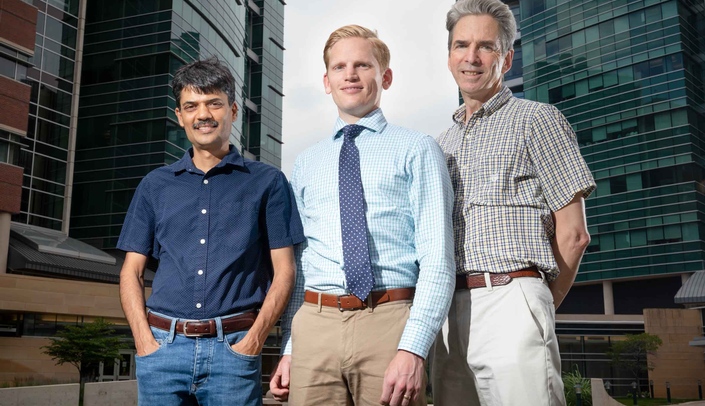A University of Nebraska Medical Center research team has used special knockout mice to determine the importance of the calcium sensor protein in initiating the eyesight process. The research appears in the June 7 online version of eLife, a high-impact journal that helps scientists accelerate research communication and discovery through its innovative open-source tool.
The role of the calcium sensor protein, known as synaptotagmin (Syt1), in interacting with rod and cone photoreceptor cells in the retina has been a long-standing question in what occurs in the beginning process of vision.
In the research study, Syt1 was selectively eliminated from specific cell types in mice by using a breakthrough technology in genome engineering known as Easi-CRISPR developed at UNMC. As the acronym implies, this technique allows scientists to custom-engineer important animal research models much more rapidly and at a significantly lower cost.
Syt1 is critical to many nerve cells and so eliminating it from the body causes mice to die within 48 hours after birth, before the retina is fully formed. To study this essential protein, the research team – headed by Wallace Thoreson, Ph.D., the Gilmore Professor of Ophthalmology and Visual Sciences and director of research for the Stanley M. Truhlsen Eye Institute at UNMC – selectively deleted Syt1 from rod and cone photoreceptor cells in the retina of the eye.
"We knew that the calcium sensor used by rods and cones of amphibians has some unusual properties," Dr. Thoreson said, "and so we were surprised that Syt1 plays such a key role in mice. We proved that – without Syt1 – the mice couldn’t transmit the signals to the brain that begin the vision process."
Dr. Thoreson said the research highlights how important Syt1 is to the overall health of the whole body and ultimately could help scientists conducting research on a variety of eye and brain diseases in the future. He noted that while mutations to Syt1 are often lethal, Syt1 also has been linked to neurological deficits.
"If you want to fix the broken clock, it’s important to know how the clock runs in the first place," said Dr. Thoreson, who was senior author on the paper. "We now have a much better understanding of how important Syt1 is to brain and retinal function. This is critical information that will benefit researchers worldwide."
Dr. Thoreson recognized Channabasavaiah (Guru) Gurumurthy, Ph.D., associate professor, pharmacology & experimental neuroscience, and director of the Mouse Genome Engineering Core Facility for his work with Easi-CRISPR that created the genetically modified mice that were essential for this research. In 2017, Dr. Gurumurthy and his longtime collaborator, Masato Ohtsuka, Ph.D., of Japan's Tokai University, developed the Easi-CRISPR technique.
"There are about 20,000 genes in mice," Dr. Gurumurthy said. "Some – such as Syt1 – are very essential. We know that without Syt1 the mice will die. It’s like taking a heart away from a person. You can’t do it or they will die."
Using the Easi-CRISPR technology, a gene can be inactivated in a given tissue rather than in the whole organism (called conditional knockouts). Conditional knockouts do not die, and they can be used for biological studies.
"More than a dozen different mouse models were generated in the proof of concept Easi-CRISPR study that was published about two years ago. The Syt1 mouse is the first of those to be characterized to solve a biological problem," Dr. Gurumurthy said.
Dr. Gurumurthy was assisted by two key people at UNMC – Rolen Quadros, transgenic researcher, and Don Harms, transgenic specialist – in developing the knockout mice.
The first mouse was engineered in about three months and the remaining mice used in the study were bred over the course of about two years. Dr. Gurumurthy said creating these mice in two years with Easi-CRISPR is about half the time it would typically take with the traditional methods.
Justin Grassmeyer, Ph.D., an M.D./Ph.D. student at UNMC, is the first author on the study. He used the novel mouse line to selectively eliminate Syt1 from either the rod or cone photoreceptor cells. He also completed an array of difficult experiments to show that Syt1 is the principal calcium sensor in both rods and cones.
Rods and cones are the photoreceptors in the retina that capture light, convert light energy into neural signals, and then transmit those signals to downstream neurons, beginning the process of vision. Rods are essential for night vision, while cones are essential to day vision.
Two research technicians in ophthalmology and visual sciences, Asia Cahill and Cody Barta, and Cassandra Hays, a graduate research assistant in cellular/integrative physiology, assisted Dr. Grassmeyer in his experiments.
We are Nebraska Medicine and UNMC. Our mission is to lead the world in transforming lives to create a healthy future for all individuals and communities through premier educational programs, innovative research and extraordinary patient care.
Twitter | Facebook | Instagram | YouTube | Flickr
